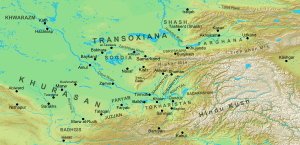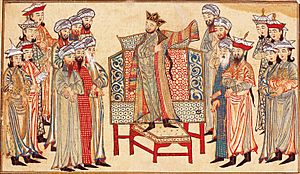Ahmad Maymandi facts for kids
Quick facts for kids
Ahmad Maymandi
|
|
|---|---|
| Vizier of the Ghaznavid Empire | |
| In office 1013–1024 |
|
| Monarch | Mahmud of Ghazni |
| Preceded by | Abu'l-Hasan Isfaraini |
| Succeeded by | Hasanak Mikali |
| Vizier of the Ghaznavid Empire | |
| In office 1031–1032 |
|
| Monarch | Mas'ud I |
| Preceded by | Abu Sahl Hamdawi |
| Succeeded by | Ahmad Shirazi |
| Personal details | |
| Born | 970s Maymand, Zabulistan |
| Died | 31 December 1032 Herat, Khorasan |
| Children | Abd al-Razzaq Maymandi Sa'id Maymandi |
| Parent |
|
Ahmad Maymandi (died December 31, 1032) was an important Persian official. He served as a vizier, which is like a chief minister or top advisor, for the Ghaznavid Empire. He worked for two powerful Ghaznavid rulers: Mahmud of Ghazni and his son, Mas'ud I of Ghazni.
Maymandi grew up as the foster brother of Prince Mahmud. He started his career in government in the region of Khorasan. He quickly rose through the ranks. In 1013, he became the vizier of the Ghaznavid Empire. He held this important job until 1024. At that time, he was arrested because he had become very wealthy, which made the ruler Mahmud suspicious.
After a short civil war in 1030, Mahmud's son Mas'ud I became the new ruler. Mas'ud freed Maymandi and asked him to be vizier again. Maymandi first said no, but then accepted in 1031. His second time as vizier lasted only one year. He died in Herat in 1032. Ahmad Shirazi took over his role.
Contents
Biography
Early Life and Career
Ahmad Maymandi's father, Hasan Maymandi, was from a town called Maymand. This town was in a region known for stories about the legendary warrior Rostam. Hasan was a governor in the city of Bust. He worked for Sabuktigin, who was Mahmud's father. Sabuktigin's kingdom was a "vassal state." This means it was a smaller kingdom that answered to a larger one, the Samanids.
Ahmad Maymandi was the foster brother and school friend of Mahmud. They both grew up in the same area. Maymandi started his government career in 994. He was in charge of letters and messages for Mahmud in Khorasan. Later, he became the chief accountant and head of the army's department. He also became the governor of Bust and Rukhkhaj.
In 997, Sabuktigin died. His son Ismail became the new ruler. But Mahmud had more experience. He fought his brother and won control of the Ghaznavid Empire in 998. Mahmud then started to become more independent from the Samanids. Eventually, he and another group, the Karakhanids, divided the Samanid lands. This ended the Samanid dynasty.
First Time as Vizier
Mahmud's first vizier was Abu'l-Hasan Isfaraini. In 1010, Isfaraini was removed from his job and put in prison. Maymandi then became the governor and tax-collector of Khorasan. People in the region liked him. He also managed to give a lot of money to Mahmud, who always needed funds. Two years later, in 1012, Maymandi was finally made Mahmud's vizier.

Maymandi worked to make the empire more organized and controlled from the center. He also tried to bring back Arabic as the main language for government papers. Before him, Persian was used. However, this change to Arabic was not very successful.
Maymandi had some enemies, like Altun Tash and Hasanak Mikali. Hasanak later became vizier after Maymandi. Maymandi also had supporters, including Prince Mas'ud I.
In 1017, Maymandi and Mahmud decided to invade Khwarazm. This region was ruled by the Ma'munid dynasty. Ghaznavid sources said they wanted to get revenge for the murder of Mahmud's brother-in-law. But historians believe Mahmud used this as an excuse to expand his empire. The Ghaznavid army took over Khwarazm. Altun Tash was made the new governor there.
In the early 1020s, Maymandi suggested that Mahmud invade Jibal. This area was ruled by a young Buyid leader, Majd al-Dawla. However, the real power in Jibal was Majd al-Dawla's mother, Sayyida Shirin. Mahmud did not agree to invade. He did not feel threatened by a woman ruling the region.
In 1024, Maymandi had become very rich. Because of this, Mahmud removed him from his position. Mahmud took all of Maymandi's property and put him in prison in Kalinjar Fort in India. Some nobles who disliked Maymandi wanted Mahmud to execute him. But Mahmud decided to spare Maymandi's life.
Second Time as Vizier and Death

When Mahmud died in 1030, a civil war started. His two sons, Mas'ud I and Muhammad Ghaznavi, both wanted to be ruler. Mas'ud won the civil war. He then ordered Maymandi to be released from prison. Mas'ud met Maymandi in Balkh and offered him the job of vizier again. Maymandi first said no, but then agreed. He started his second time as vizier in 1031.
He was given full control over money matters and government inspectors. Maymandi was not as rich as he used to be. But he gave food and money to people who needed it. He also sent expensive gifts to Mas'ud. He did this to avoid making Mas'ud jealous, which had caused problems with Mahmud before.
Maymandi then got revenge on some of his enemies. But he forgave others, including Hasanak. Maymandi tried to save Hasanak from being executed, but he failed. In the same year, Maymandi approved Mas'ud's choice to make Ali Daya the army commander in Khorasan. He also appointed Abu Sahl Zawzani as the chief army administrator. Maymandi died on December 31, 1032, in Herat. Ahmad Shirazi became the new vizier.
Maymandi had a son named Abd al-Razzaq Maymandi. He also became a vizier later. Maymandi had another son, Sa'id Maymandi. Sa'id had a son named Mansur ibn Sa'id, who also held important government jobs.
Legacy

Ahmad Maymandi was one of the most important government leaders of his time. People who wrote about him praised him. They admired how he dealt with his enemies. They also liked his approach to the Seljuqs and his advice on other important matters. He was also very good at choosing people for jobs.
Poets also praised Maymandi. For example, Farrukhi Sistani wrote fifteen poems in his honor. The poet Unsuri wrote two poems for him. Maymandi, along with Mahmud, helped make Ghazni a major center for Persian culture. It became a successor to the cultural center of Samanid Bukhara.
From the sages who have gathered at your court,
You are making Ghazni just like Greece.
A historian named Utbi, who worked with Maymandi, also praised him. According to a 12th-century poet, Nizami Aruzi, Maymandi even tried to help the famous Persian poet Ferdowsi. Ferdowsi was trying to get Mahmud's support for his epic poem, the Shahnameh. Maymandi also reportedly supported the Iranian scholar al-Biruni against Mahmud, though this is debated. Abu Sahl Hamdawi, who held high positions in the Ghaznavid government, was a student of Maymandi.
Maymandi was strict with his government workers. He was very dedicated to keeping the state strong. The historian Bayhaqi wrote about Maymandi in his last days. He said Maymandi was harsh with tax collectors. But Bayhaqi also sadly noted that with Maymandi's death, "bravery, honesty, ability, and greatness all passed away."
|
| Preceded by Abu'l-Hasan Isfaraini |
Vizier of the Ghaznavid Empire 1013–1024 |
Succeeded by Hasanak Mikali |
| Preceded by Abu Sahl Hamdawi |
Vizier of the Ghaznavid Empire 1031–1032 |
Succeeded by Ahmad Shirazi |


